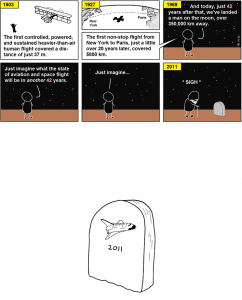In honor of the last Space Shuttle flight, the journal Science has a retrospective by Dan Charles (behind a paywall, I think) on the science achievements of the shuttle. People who’ve paid a lot of attention to science and the space program over the years will already know the main points, but it’s worth a read for those who haven’t. The most useful part is the timeline (also paywalled, I assume).
To tease out the scientific contributions of the shuttle, Science has grouped the program's 134 missions into five categories. (The sixth, and largest, category is those missions with little or no scientific activity.) By frequency, the exploration of microgravity leads the way, with a substantial amount of such research aboard 45 missions. In second place are major observations of Earth or the heavens (12 missions), followed by the launching of large scientific instruments (seven missions), repairs and upgrades to the Hubble telescope (five missions), and research on the effects of the external space environment (three missions).
The shuttle did launch three “great observatories” — Hubble Space Telescope, Chandra (X-rays), Compton GRO (gamma-rays), which have been amazing tools. As Charles puts it,
All the instruments have led to stunning scientific advances€” but all could have been launched on crewless rockets.
The shuttle was a crazily overpriced way to do this science.
One thing the shuttle did do that couldn’t have been done with crewless rockets: service, repair, and upgrade Hubble. Economically, this still isn’t worth it: you’d be better off just building and launching a new telescope for the cost of the servicing missions. Charles notes a counterargument:
Critics of crewed space flight point out that NASA could have built and launched an entirely new space telescope for the price of the repair missions. But Grunsfeld says that's unrealistic; it would have taken longer to build and launch a second-generation Hubble, for one thing, and there's no guarantee the project would have been completed.
If I understand it correctly, this is a claim that, due to the irrational way we allocate funds, it would have been politically unfeasible to do the science in a more efficient way. That may be true, for all I know.
Other than the great observatories, the main impression I get from this piece is how little science has come out of the shuttle and the international space station. Estimates of the cost of the ISS vary, but it’s at least $100 billion, and the cost of the shuttle program is something like $170 billion. There’s overlap in those two numbers — the first one includes the cost of shuttle flights to service the ISS — so you can’t just add them up. But anyway, it means that the combined cost of the programs is at least 60 times the cost to the US government of the Human Genome Project. For that kind of money, we should be opening up vast new scientific vistas, but they’re nowhere to be found.
Of course, all this says is that the shuttle and space station are failures when viewed as science projects. If we acknowledge that science is not and never has been the primary purpose of human space flight, then this isn’t the right yardstick to use in measuring the programs’ success.
If not science, what is the point of the human space flight program, then? The three I’ve heard people talk about are
- the intrinsic awesomeness of exploration (“going where no one has gone before”),
- inspiring the next generation of scientists and engineers,
- somehow doing something nice for international relations.
I don’t buy the first two. What we’ve done for the past 40 years in human space flight is not exploration in any meaningful sense, and I see no evidence that it’s inspiring. I don’t have any knowledge that lets me evaluate the last one, but I’ve never seen any argument that persuades me that our relations with Russia (or anywhere else) are better than they otherwise would be, to the tune of hundreds of billions of dollars, because of the ISS.
The comic Abstruse Goose reacts with sadness to the end of the shuttle program:
But the real sadness occurred at the beginning of the shuttle program, when we decided to put all our effort into shipping stuff back and forth to low-Earth orbit, so that we completely forgot how to do real exploration.

I can’t really speak to the value of the space shuttle in promoting international cooperation, particularly with Russia, but I can’t imagine it’s been as large as that of the Nunn-Lugar program. That’s a scientific cooperation program that had real tangible value in preventing weapons proliferation by both securing fissile material and keeping Russian scientists from selling their services abroad. To the extent that some Russian rocket scientists were employed in supporting the shuttle program rather than helping Iran build ICBMs, the shuttle program may have contributed to this, but it’s likely marginal to the overall size of Nunn-Lugar.
Nunn-Lugar is a great example of a really worthwhile initiative. A guy in my department actually spent a year in DOD as a nuclear physics consultant of some kind, working on that program.
I already miss it being so close to where they launch. I saw the second to last shuttle launch but couldnt see the last. Very sad 🙁
Scientific wasn’t the point. The shuttle program was necessary for political reasons. The space shuttle was a relatively cheap way to put multiple astronauts in orbit. It was good PR and it secured NASA funding.